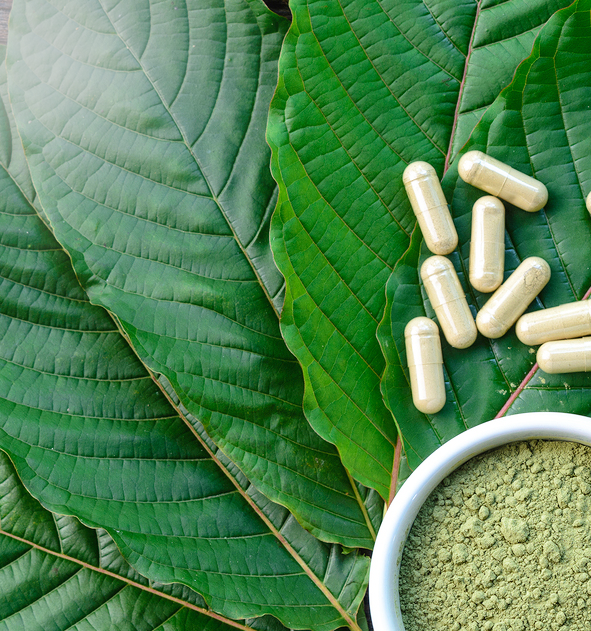“Kratom” and “Kratom Extract” preparations are now widely available throughout the United States and via the Internet. Kratom is the common name of a plant native to Thailand whose botanical name is Mitragyna speciosa (Family: Rubiaciae), but it is often unclear or unknown how much of the preparations sold as “Kratom” actually contain Mitragyna speciosa, or if they contain additional botanicals or chemical adulterants.
As a result, Herb Research Foundation does not sell “Kratom” –HRF sells only Mitragyna speciosa documented by both in-house inspection standards and third-party testing not only to be authentic, but also to be free of chemical and biological contaminants.
Preparations currently sold as Kratom elsewhere may indeed contain Mitragyna speciosa, but the plant is continually at risk for both accidental and deliberate adulteration and contamination for the following reasons:
Reputation as a psychoactive: whole fresh and dried leaves of the Mitragyna speciosa plant has been used in Southeast Asia for millennia as a stimulant, analgesic, antidepressant, antidiarrheal, and antitussive remedy. “Kratom” is widely marketed as a supplement to promote energy, relaxation, and anxiety and pain relief. While experiences with Mitragyna speciosa vary widely with the individual and with the dose, its reputation as the source for a “natural high” has made “Kratom” both highly popular with curious consumers as well as somewhat suspect to regulatory authorities and to the conventional herbal products industry, who are understandably nervous about the consequences of potential consumer misuse of “Kratom.” As a result, neither “Kratom” nor Mitragyna speciosa can be found at supplements or natural food stores where herbs like Kava Kava, Valerian Root, or Passion Flower are typically sold under branding by large botanical preparation or supplements companies with longstanding experience in the industry and reputations to protect. In the United States, “Kratom” is only widely sold at smoke shops, gas stations, and convenience stores, and of course, online via various websites from online-only vendors. This nontraditional commercial route of Mitragyna speciosa compared to other botanical supplements means that in general, both wholesalers and vendors of “Kratom” have less experience preparing and selecting quality botanicals as well as less accountability for their preparations through the traditional incentives of brand and store reputation.
Abuse potential: the primary alkaloid found in Mitragyna speciosa is mitragynine, an indole alkaloid that has agonist effects on opioid receptors in laboratory in vitro tests and evidence of antinociceptive effects in animal testing. Other alkaloids found in smaller Mitragyna speciosa or metabolic derivatives of mitragynine may contribute to opioid receptor-mediated analgesic activity as well. As a result, there is legitimate concern by medical professionals and government regulators that “Kratom” could have similar risks for physical dependence and addiction in humans to pharmaceutical opioid agonists like codeine and morphine. While mitragyninine has been confirmed in lab and animal tests to be much weaker than any pharmaceutical opioid, and unable to cause the opioid receptor-mediated respiratory depression that pharmaceutical opioids can typically cause at both therapeutic and excessive doses, preparations labeled “Kratom” are continually subject to adulteration by pharmaceutical opioids, illegal opioid derivatives, or other illegal drugs by suppliers looking to capitalize on Mitragyna speciosa’s potential analgesic or reputed psychoactive effects. While the extent of Mitragyna speciosa’s ability to cause dependence or addiction on its own remains to be fully documented by rigorous or extensive clinical studies in humans, Mitragyna speciosa should always be used with caution, and its chronic use for any perceived physical symptom or medical condition should ideally be monitored by a health care professional.
Financial incentives: unlabeled substitution or dilution of botanical products with lower-cost, undisclosed ingredients of either botanical or synthetic origin in order to increase profitability is an issue of perennial concern to the supplements industry. While the Dietary Supplement Health and Education Act of 1994 (“DSHEA”), defines and regulates dietary supplements and gives the federal Food and Drug Administration (FDA) the authority to monitor dietary supplements manufacturers for Good Manufacturing Practices under 21 CFR Part 111, it is often impossible to determine which manufacturers are truly following these practices until patients start reporting problems with supplements. Furthermore, the emergence of the Internet as an arena for quick anonymous sales of supplements has contributed to the risks that unscrupulous or uneducated suppliers are looking to make a quick buck from a consumer demand. The fact that established herbal supplements companies and conventional natural foods and supplements retail establishments avoid Mitragyna speciosia, yet “Kratom” continues to be widely available at gas stations, convenience stores, and smoke shops, increases the risks that different species of cheaper or easier to obtain botanicals or the addition of synthetic adulterants are packaged into capsules or bottles and sold as “Kratom.”
Although there are ethical and responsible manufacturers and retailers in the industry, because of the above risks, any preparation sold as “Kratom” should therefore be considered suspect until proven otherwise. This is the primary difference between Mitragyna speciosa and “Kratom”: the label “Mitragyna speciosa” legally indicates the preparation contains the specific botanical Mitragyna speciosa, while “Kratom” inadvertently or on purpose lacks a rigorous or specific definition, so it can mean virtually anything. Consumers have the right to know what is in their products as well as where they came from, so that is why the authenticity and quality of Mitragyna speciosa must be determined by correct botanical taxonomy with vouchers, objectively verifiable organoleptic standards, and chemical analysis via established testing methods before any preparation labeled with that name reaches the consumer.


Your writing has a way of resonating with me on a deep level. I appreciate the honesty and authenticity you bring to every post. Thank you for sharing your journey with us.